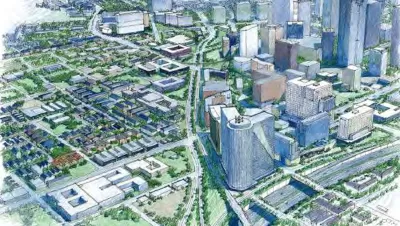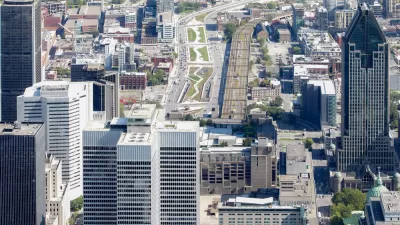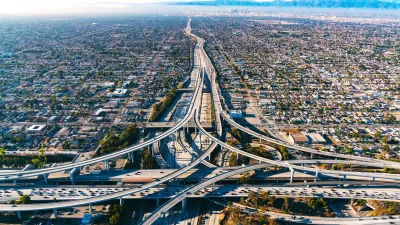With the new administration placing racial justice and equity at the forefront of transportation policy, will America finally reckon with the legacy of its freeways?

In a piece for Common Edge, William Fulton describes a scene that's all too common in many American cities: a dense, walkable downtown, brimming with diverse uses and businesses, sliced through by a massive freeway overpass. "In almost every urban location I have ever lived, a midcentury transportation scar stretches across the landscape and makes navigation difficult for pedestrians," writes Fulton. These scars reveal the inequities of top-down policies whose effects continue to reverberate throughout communities, even as city leaders attempt to redress past injustices and rectify their negative impacts.
"The complicated truth is that even as these freeways destroyed and divided neighborhoods, they also provided regional access to downtowns and other central-city locations that were struggling in the postwar suburban era. And in recent years they may have helped the rebirth of urban neighborhoods by giving city residents easy driving access to suburban job centers and also giving shoppers easy access to historic Main Streets."
The current "Big Rethink" around highways is an opportunity to challenge assumptions and find creative ways to repair the damage without sacrificing mobility. Around the country, cities are looking at ways to replace elevated freeways with boulevards, build freeway caps (which create valuable public and private real estate, albeit still near a major source of air pollution), and reduce the number of on and off-ramps to increase land available for other uses while maintaining the flow of traffic. "Healing urban scars and reclaiming the urban environment comes with a steep price tag—and doesn’t always expand freeway capacity, which is usually the primary driver of state and federal transportation funding," Fulton says, but successful examples like Dallas's Klyde Warren Park and San Francisco's Embarcadero show that alternatives are possible.
FULL STORY: Repairing the Urban Fabric Ruined by Highways

Alabama: Trump Terminates Settlements for Black Communities Harmed By Raw Sewage
Trump deemed the landmark civil rights agreement “illegal DEI and environmental justice policy.”

Planetizen Federal Action Tracker
A weekly monitor of how Trump’s orders and actions are impacting planners and planning in America.

The 120 Year Old Tiny Home Villages That Sheltered San Francisco’s Earthquake Refugees
More than a century ago, San Francisco mobilized to house thousands of residents displaced by the 1906 earthquake. Could their strategy offer a model for the present?

In Both Crashes and Crime, Public Transportation is Far Safer than Driving
Contrary to popular assumptions, public transportation has far lower crash and crime rates than automobile travel. For safer communities, improve and encourage transit travel.

Report: Zoning Reforms Should Complement Nashville’s Ambitious Transit Plan
Without reform, restrictive zoning codes will limit the impact of the city’s planned transit expansion and could exclude some of the residents who depend on transit the most.

Judge Orders Release of Frozen IRA, IIJA Funding
The decision is a victory for environmental groups who charged that freezing funds for critical infrastructure and disaster response programs caused “real and irreparable harm” to communities.
Urban Design for Planners 1: Software Tools
This six-course series explores essential urban design concepts using open source software and equips planners with the tools they need to participate fully in the urban design process.
Planning for Universal Design
Learn the tools for implementing Universal Design in planning regulations.
Clanton & Associates, Inc.
Jessamine County Fiscal Court
Institute for Housing and Urban Development Studies (IHS)
City of Grandview
Harvard GSD Executive Education
Toledo-Lucas County Plan Commissions
Salt Lake City
NYU Wagner Graduate School of Public Service





























